The logic behind the BEE PATH concept is very simple – bees live in a healthy environment. If European cities manage to preserve and improve the natural environment in urban areas, which allows bees and other wild pollinators to thrive, then they are on the right path to environmental protection, preserving the biodiversity, ensuring high-quality living conditions and preservation of food self-sufficiency potentials.
Sounds straightforward and logical, right?! However, how hard is it to actually achieve this in a modern European city with all its needs and challenges?
“It is not easy, but it is also not impossible!” says Maruška Markovčič – the BEE PATH good practice developer in the City of Ljubljana and the Project Coordinator for the BeePathNet project – and continues: “The most important thing for any city is to first decide that they actually want to develop and implement their sustainable urban policies. Then the process of making our cities more sustainable can start.”
In Ljubljana – the capital of Slovenia where 290,000 citizens coexist with over 180 million bees and who knows how many wild pollinators – this process started in 2005 with development of a new sustainable city development strategy “Vision 2050” and a new Spatial Plan. In about 10 years Ljubljana won the title of “the Green Capital of Europe 2016”.
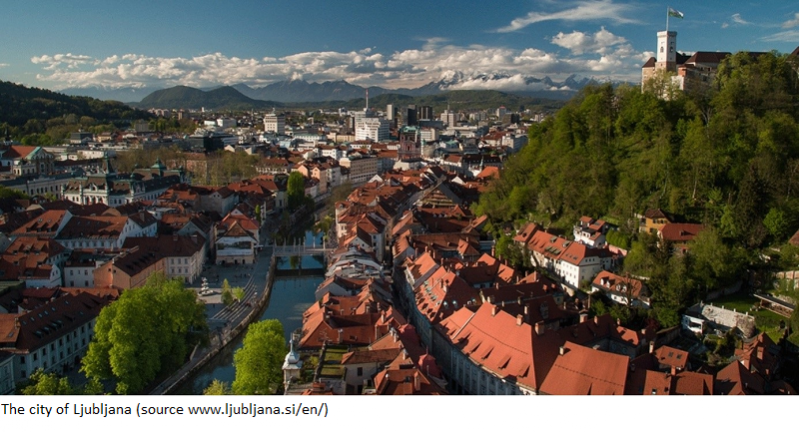
One would think that such a reward would represent the crown achievement. However, it proved to be just a springboard, as the success provided a supportive and nurturing environment for bolder green urban development ideas and projects. In the following years, the City of Ljubljana encouraged and supported new urban concepts including urban gardening, urban forestry, and urban beekeeping.
An excellent example of such efforts is the BEE PATH, which became the synonym for all activities linked to bees and wild pollinators in Ljubljana. Through two and a half years of its existence it evolved to become:
- A NETWORK of partners interested in urban beekeeping – providing a platform for discussion on challenges, searching for solutions and development of new products on a voluntary basis.
- A TOURISTIC AND EDUCATIONAL PATH designed to connect urban beekeepers and other bee-related points of interest, thus presenting the importance of bees and urban beekeeping to visitors.
- AN EDUCATIONAL PROGRAMME devoted to raising awareness amongst target audiences.
- A “THINK-TANK” AND AN “INCUBATOR" for development of new entrepreneurship ideas.
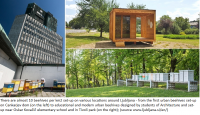
Its success was on the European level recognized by URBACT Programme, as it was declared a good practice. Maruška explains: “This enabled the City of Ljubljana to reach out to other European cities and develop the BeePathNet project with one clear goal - to replicate the success of Ljubljana and transfer the BEE PATH good practice to other cities.”
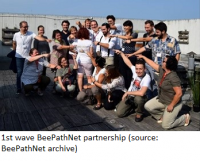
The BeePathNet partnership linked six EU Cities – Ljubljana (SLO) as the lead partner, Cesena (ITA), Bydgoszcz (POL), Amarante (POR), XII. District of Budapest (HUN) and Nea Propontida (GRE) as 1st wave partners under the URBACT transfer networks framework. Such partnership allowed the BeePathNet project to cover the majority of climate conditions for beekeeping in EU (fore example Atlantic, Continental, Mediterranean and Alpine climate conditions), as well as to take into account cultural and social differences between EU cities during the transfer process.
“Through it, we proved not only that the BEE PATH concept can be adapted and transferred to other European cities, but also that the good practice itself can be further evolved – based on knowledge and experience gained from transfer cities.” Maruška says and continues: “The BeePathNet project also allowed us to understand the importance of the flexibility in the transfer process. Or in other words - how to adapt modality and content of the bee path to actual needs of transfer cities, how to connect the bee path story with already existing own good practices in transfer cities and how to make sure all six bee paths remain connected on the transnational level.”
Good practice description, transfer methodology, knowledge and own good practices form transfer cities, as well as all lessons learned during the transfer process, were collected in the document titled The evolution steps toward a bee-friendly city – a comprehensive guidebook that can easily be used by any city interested to follow the example of the BeePathNet partnership.
“It was such an intensive learning experience for all of us… And you only realize this by taking your time and going through all these fantastic outputs we produced together. I am so proud of all project partners – not because they created bee paths in transfer cities, but because they made them unique!” Maruška concludes her thoughts on the 1st wave partnership: “It is because of them and their efforts that the transfer process can be considered successful. And you know, success opens new doors…”
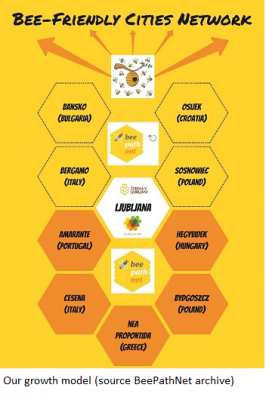
Encouraged by successful transfer of the good practice to 1st wave transfer cities, URBACT Programme provided an opportunity for the City of Ljubljana as the Lead partner to enlarge the network and replicate the transfer process with four additional European Cities. Osijek (CRO), Bergamo (ITA), Bansko (BG) and Sosnowiec (POL) accepted the challenge and became the 2nd wave partners of the BeePathNet – Reloaded project.
The 2nd wave is understood by the City of Ljubljana as a very unique opportunity. On one hand it is a perfect opportunity to expand the network of bee-friendly cities, but on the other hand it as also the opportunity to go one step further and address issues the partnership could not address in the 1st wave.
Maruška explains: “Suddenly we were no longer 1 of 23 Transfer Networks under the URBACT umbrella, but 1 of only 7 Transfer Networks allowed to continue in the 2nd wave. You start thinking – wow, someone else believes we are doing something right! And this brings certain pressure… Not because we were not confident about the transfer potential of the BEE PATH good practice to 2nd wave transfer cities, but because this forced us to rethink our long-term goals and the strategy to achieve them.”
The BeePathNet project has shown how to take a sustainable urban development policy and put it into practice – not in one, but in six European Cities. With the BeePathNet – Reloaded project we will do the same in four more cities. And this is already a considerable result that should be promoted and shared with a wider audience.
This is why Maruška is very clear on the ambition of the BeePathNet – Reloaded project: “We want to expand the network with the BeePathNet – Reloaded project and spread our key messages. Not only to our 2nd wave transfer cities, but primarily to decision makers on local, regional, national and European level.”
As the BEE PATH concept relied on the bottom-up approach and successfully mobilised citizens in its implementation, we were able to do it with limited, but well managed, resources. This is more important than one would think, as non-investment and smaller-budget projects are often considered less important by decision makers. Maruška explains: “Just as crowd-sourcing proved that citizens can significantly impact innovation and development, we have to raise the awareness of decision makers that citizen driven initiatives can successfully spearhead the implementation of sustainable urban policies – efficiently, effectively and with high impact on the community. We simply need their political and operational support.”
Then Maruška points out another issue – the negative approach used by decision makers when discussing implementation of any new policy. “Constantly pointing out all the challenges linked to sustainable urban policy implementation, when one can simply switch the rhetoric and look for partners who are interested in exploiting opportunities coming out of the new policies doesn’t make much sense to me.” She continues: “Because we relied on our citizens to implement the policy in practice and allowed citizens to exploit synergies for their own growth and development of new small business opportunities, we created a multi-win situation. Through implementation of the policy, we improved the living conditions in our city, enabled sustainable development, rose the awareness, created citizen ownership and subsequently ensured the policy longevity.”
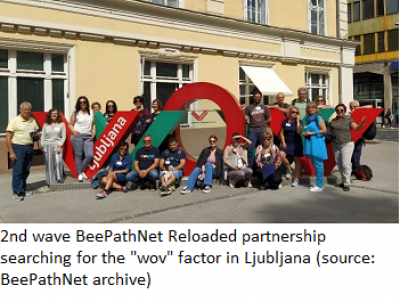
The proof of that can be found in 1st wave transfer cities, as all of them developed Long-term Urban Beekeeping Development Plans, as well as maintained the dynamics of regular ULG meetings after the BeePathNet project ended. Maruška continues: “It is so important to make sure we involve 1st wave transfer cities and use them as knowledge hubs and trainers for 2nd wave transfer cities. If we stay connected and keep the momentum going, our key messages will be so much stronger.”
As the BEE PATH concept was based on urban sustainability concept and developed to bridge the mistrust between the city administration and citizens, it can be easily reused to address other urban challenges. Maruška adds: “The more I think about it, the more I realize that we succeeded in creating a model for citizen involvement in almost any policy implementation process.”
“If decision makers are serious about implementation of the Green Deal and other sustainability policies, they should understand the value of ready-to-implement policy implementation models, such as the BEE PATH, and support us.” Maruška concludes.
And then our discussion turns to a more distant vison of the future. In it, after successful implementation of the BeePathNet – Reloaded project, the BEE PATH concept becomes a well known and used approach, while the Bee-Friendly Cities Network becomes an important mechanism for city-to-city cooperation. As such it is able to work with cities across EU on implementation of their sustainable urban policies – thus, making European cities more sustainable and resilient.
It is a challenge, we know! However, as they say: “A landslide starts with the first pebble!” Well, we have moved at least ten pebbles so far and proved that it can be done. This is why we dare to invite all European Cities to join the Bee-Friendly Cities Network and participate in this urban sustainability landslide.



